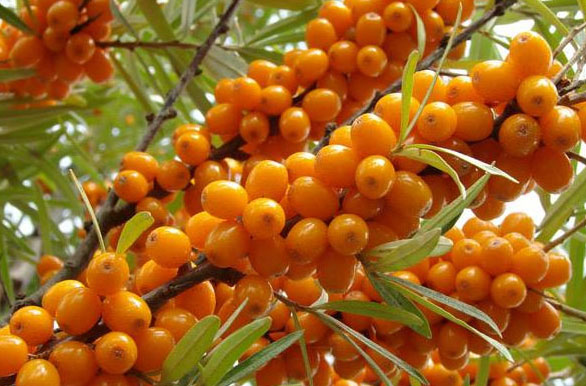Sea buckthorn (Hippophae spp.) is a deciduous shrub or medium sized tree belongs to the family ‘Elaeagnaceae’ which grow naturally at higher altitudes of temperate zone of Asia and Europe. The total distribution of this species is in three main countries, namely China, Mangolia and former USSR is approximately 8, 10,000 ha (natural growth) and 3, 00,000 ha (plantation). Out of this approximately 7, 40,000 ha and 3, 00,000 ha of natural and cultivated plants, respectively are in China. After China, Indian Himalaya is believed to possess about 1, 00,000 ha, the world’s second largest resources.
In India, locally known as Amesh, Aameel, Tarwar, Cook, Amleshu, Imli, Turo is generally found in higher hills of Himachal Pradesh, Uttarakhand and Jammu and Kashmir. In Himachal Pradesh, the species grows mainly in the district of Lahaul-Spiti, a cold desert area adjoining Tibet in eastern region and Ladakh in north. In Uttarakhand, it is grown wild on sandy loam soils, on river banks and steep slope of hills between 2200 to 4000 m msl. The surveys have estimated over 50,000 ha area under Seabuckthorn in Ladakh. It has an ability to fix atmospheric nitrogen through Frankia symbiosis, thus helps in soil amelioration. It develops extensive root system in a short period of time, therefore it is planted for soil conservation and erosion, strengthen sandy slopes. It bears yellow or orange to red berries, which have been used for centuries in Europe and Asia due to the medicinal and nutritional properties.
Seabuckthorn (SBT) is known to possess unique characteristics, including robust growth and higher survival under limited resource environments and adverse climatic conditions. This phenomenon explains its status as ‘‘A wonder plant of the Himalayas’’ and can be opted for overall environmental conservation and ecological rehabilitation of fragile marginal-high mountain farming systems with potential for higher economic return. The uses of Seabuckthorn are manifold and include its use as fence, fuel, fodder, fruit and medicines. This species has great ecological significance as its roots possess excellent soil binding properties. Frankia present in the root nodules fixes atmospheric nitrogen @180 kg/ha/annum. Natural forest of Seabuckthorn can yield 750-1,500 kg of berries/ha.
The fruits are considered as a storehouse for several valuable vitamins, minerals, and specialty bio-molecules, which provide unique opportunity to use this plant in nutraceutical and pharmaceutical industries. The berries are a rich source of vitamin B1, B2, K, C, A, caretonoids, minerals, xanthophylls, phenolics, and flavanoids. Seeds contain high quality oil which has many bioactive substances. It is also reported that concentrated juice significantly inhibits the growth of sarcoma, lymphocyticleukemia and human gastric cancer cells. In China, it is used to cure against burn, gastric problems, duodenal ulcers etc. Despite of its highly acidic nature and exotic flavour, the berries are having good potential for producing various products like beverages, squash, syrup, etc. Traditionally in Himalyan region, the villagers use the fruits of seabuckthorn for making chutney, jam, soft drinks and pickle. The leaves of seabuckthorn are used to make herbal tea. Sea buckthorn oil is used for healing and rejuvenating effects on the skin. It is a great natural cleanser and exfoliator. It can also help heal burns, cuts, wounds, sunburn, rashes, and other types of skin damage. It's the only plant source that contains omega-3, 6, 9 and 7 particularly linoleic acid and alpha-linoleic acid (comprising 70 percent). Meanwhile, the fruit oil contains monounsaturated fatty acids and omega-7 (palmitoleic and palmitic acid).
So far, no domestication work has been done on this plant in Uttarakhand. The important reasons for this being lack of awareness regarding its nutritive value and use, inaccessible areas of natural stands, unavailability of technology for multiplication and multipurpose utilization with special reference to Uttarakhand hills. Through utilization of this miracle tree which is full of nutrients we can get provide self employment to un-employed youths by starting up the seabuckthorn based industries for production of medicines, beverages, jam etc and can achieve nutritional security if used by local people in their daily diet.
Table 1: Nutritional value of various fruits juices
|
Juice |
Carotenoids (mg/100 g) |
Ascorbic acid (mg/100 g) |
Tannins (%) |
Minerals (% as Total Ash) |
|
Apple |
Traces |
3.90 |
2.50 |
- |
|
Orange |
0.21 |
40.80 |
Traces |
- |
|
Papaya |
0.24 |
15.67 |
Traces |
- |
|
Lemon |
- |
36.32 |
40.70 |
0.36-0.38 |
|
Seabuckthorn |
6.80 |
516 |
0.50 |
1.76-1.80 |
